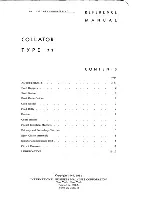
8
3931176/08/12/D - The right to make technical changes reserved!
Doepke
Engl
ish
8. Putting into Service
8.1. General Information
Installation may only be carried out by an authorized, trained technician. Observe the
connection diagram when installing. All lines to be connected must be dead.
On both operating signal sensors the Dupline signal as well as the 24 VDC supply volt-
age should connected separately. Connections between the Dupline signal and earth
potential will cause malfunctions and are not permissible. In addition, check for the cor-
rect polarity of the Dupline signal.
Connection to the Dupline bus and the 24 VDC supply voltage is via the spring-loaded
or screw terminals provided. The following table illustrates the connection configuration:
In order to avoid malfunctions, the lengths of the line between push-button and the sen-
sors should not exceed 1 m under normal environmental.
In order to meet the requirements for protective low voltage, VDE0100, Part 410, should
be observed and put into practice during installation. For reasons of safety and space
requirements, mains cables may not be routed through the same installation box (e.g. in
combined switch/socket units).
8.2. Connection of Push-buttons to DSS 4R
Standard push-buttons can be connected by means of the 4-wire system cable provid-
ed. In so doing care should be taken that the red 24 VDC lead of the first cable loom is
directed outwards. The following table illustrates the configuration of the connecting
leads:
The connection diagram is shown in
.
Terminal
Description
Terminal
Description
D+
Dupline signal con
24 VDC
Operating v24 VDC
D-
Dupline signal conductor -
0 VDC
Operating voltage 0 VDC
Pin
Color
Signal
Cable Loom
1
1
red
+24 VDC
2
blue
Cathode LED1
3
yellow
Input operating signal T1
4
green
Input operating signal T2
Cable Loom
2
1
green-black
Input operating signal T4
2
yellow-black
Input operating signal T3
7
blue-black
Cathode LED2
8
grey
Cathode BUS-OK-LED






























